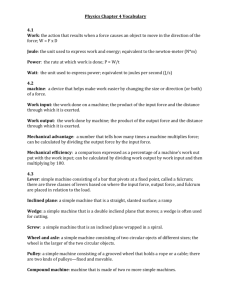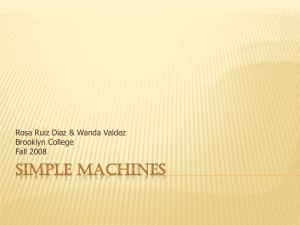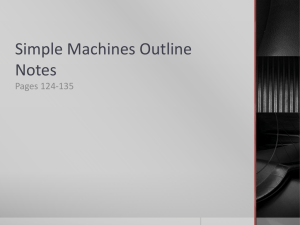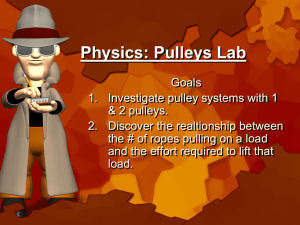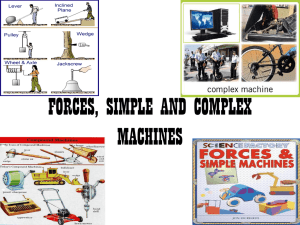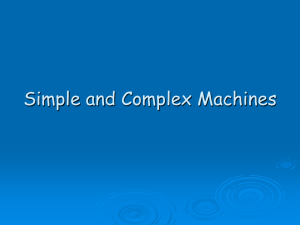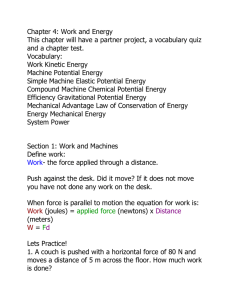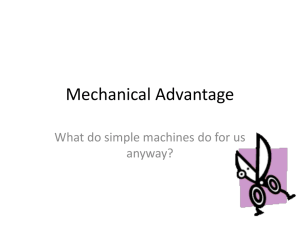PPT- Simple Machines Ken - Mounds View School Websites
advertisement
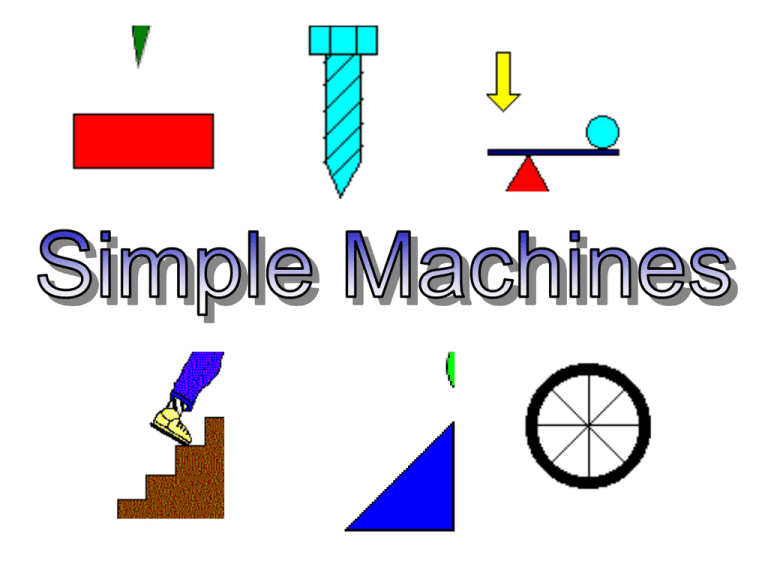
What are the six simple machines? • The Lever • The Inclined Plane • The Wedge • The Screw • The Wheel and Axle • The Pulley What is Work? • Work is defined as a force acting on an object to move it across a distance. What is Motion? • Motion is change of location or position of an object with respect to time. Work equals force times distance. Or: x W= F D 3 ways that Simple Machines make work easier. 1. By increasing the force that can be applied to an object. 2. By increasing the distance over which the force is applied. 3. By changing the direction of a force. A force is a push or pull A lever is a stiff bar that rests on a support called a fulcrum which lifts or moves loads. The parts of a lever are: • fulcrum (pivot point) • load (the thing being moved) • effort (the thing doing the moving) 1st Class Lever = fulcrum is located between the applied force and the load. Examples are: • Can opener and/or bottle opener • Crowbar • Hand trucks • Pliers (double lever) • Scissors (double lever) • Seesaw (aka teeter-totter) A 2nd class lever has the load between the fulcrum and the effort force. Examples are: • wheel barrow • hole puncher • stapler • nutcracker A third class lever is one where force is applied in between the fulcrum and the load being moved. Examples are: • Fishing rod • Tweezers • Catapult • Diving board An inclined plane is a slanting surface connecting a lower level to a higher level. An incline plane requires less force over a greater distance. The inclined plane is used to change the elevation of an object without lifting the object directly. Examples of inclined plane include wedge chisels, sloping roads, ramps, and plows. A wedge is an object with at least one slanting side ending in a sharp edge, which can be used to cut materials. A wedge is made of two inclined planes. Examples are push pins, your own teeth, nails, a sledge hammer, an axe, a knife, a razor blade, anything that splits, cuts, or divides another object including air and water. A screw is an inclined plane wrapped around a pole. A screw may be used to fasten things together, wedge things apart, cut material, or lift things. Some examples are key rings, a light bulb, a jar lid, a door knob, a bolt, an ice auger, to name a few. A wheel with a rod, called an axle, through its center used to lift or move loads. In the example to the right effort is applied to the wheel to lift a load (water). A pulley is a simple machine that uses grooved wheels that turn around an axel. A rope is used to raise, lower or move a load. A pulley changes the direction of force. Examples of pulleys include: •Elevators use multiple pulleys in order to function. •Many types of exercise equipment use pulleys in order to function. •Curtains at a theatre are moved using pulley systems that pull the curtains apart. •Flagpoles use pulleys in order to hoist the flag up or to bring it down. •Pulleys can be used to place birdfeeders high in trees or on poles. •Pulleys can be used to extend ladders. •Sails on sailboats are raised and lowered using pulleys. •Garage doors raise and lower utilizing a pulley system. •Rock climbers use pulleys to help them to climb. Energy is the capacity to do work or to perform vigorous activity. The law of conservation of energy is a law of science that states that energy cannot be created or destroyed, but only changed from one form into another or transferred from one object to another.


